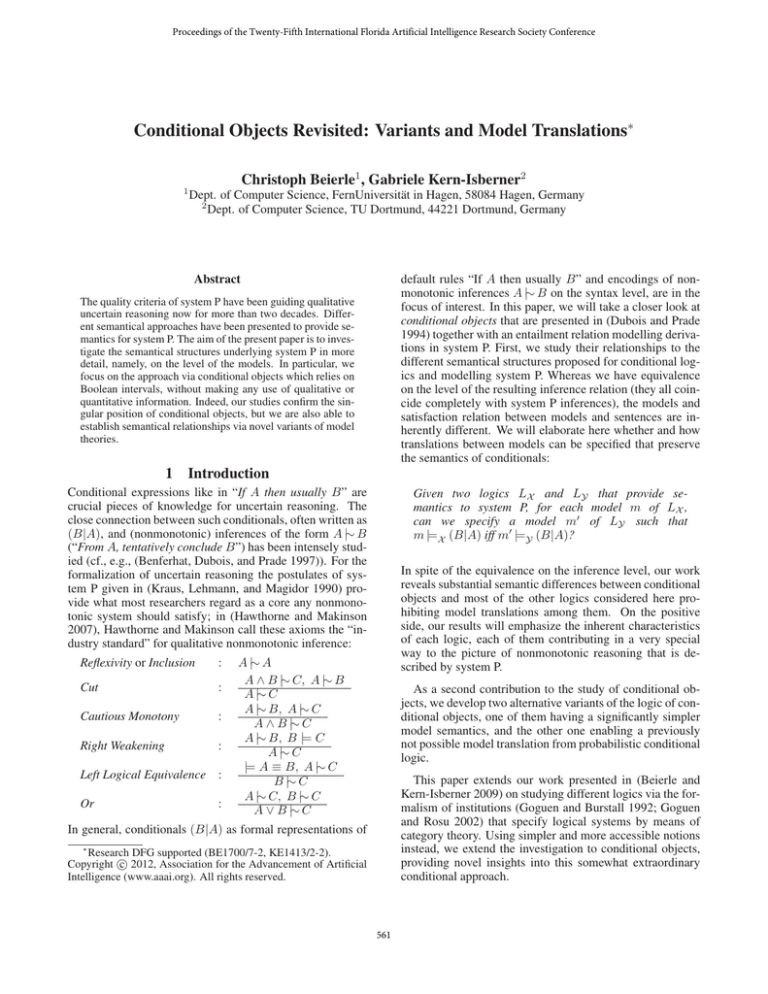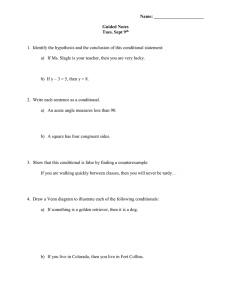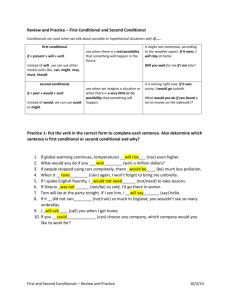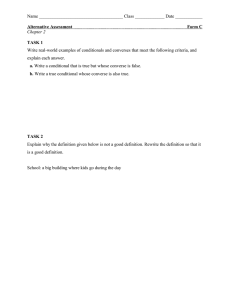
Proceedings of the Twenty-Fifth International Florida Artificial Intelligence Research Society Conference
Conditional Objects Revisited: Variants and Model Translations∗
Christoph Beierle1 , Gabriele Kern-Isberner2
1
Dept. of Computer Science, FernUniversität in Hagen, 58084 Hagen, Germany
2
Dept. of Computer Science, TU Dortmund, 44221 Dortmund, Germany
default rules “If A then usually B” and encodings of nonmonotonic inferences A |∼ B on the syntax level, are in the
focus of interest. In this paper, we will take a closer look at
conditional objects that are presented in (Dubois and Prade
1994) together with an entailment relation modelling derivations in system P. First, we study their relationships to the
different semantical structures proposed for conditional logics and modelling system P. Whereas we have equivalence
on the level of the resulting inference relation (they all coincide completely with system P inferences), the models and
satisfaction relation between models and sentences are inherently different. We will elaborate here whether and how
translations between models can be specified that preserve
the semantics of conditionals:
Abstract
The quality criteria of system P have been guiding qualitative
uncertain reasoning now for more than two decades. Different semantical approaches have been presented to provide semantics for system P. The aim of the present paper is to investigate the semantical structures underlying system P in more
detail, namely, on the level of the models. In particular, we
focus on the approach via conditional objects which relies on
Boolean intervals, without making any use of qualitative or
quantitative information. Indeed, our studies confirm the singular position of conditional objects, but we are also able to
establish semantical relationships via novel variants of model
theories.
1
Introduction
Conditional expressions like in “If A then usually B” are
crucial pieces of knowledge for uncertain reasoning. The
close connection between such conditionals, often written as
(B|A), and (nonmonotonic) inferences of the form A |∼ B
(“From A, tentatively conclude B”) has been intensely studied (cf., e.g., (Benferhat, Dubois, and Prade 1997)). For the
formalization of uncertain reasoning the postulates of system P given in (Kraus, Lehmann, and Magidor 1990) provide what most researchers regard as a core any nonmonotonic system should satisfy; in (Hawthorne and Makinson
2007), Hawthorne and Makinson call these axioms the “industry standard” for qualitative nonmonotonic inference:
Reflexivity or Inclusion
:
Cut
:
Cautious Monotony
:
Right Weakening
:
Left Logical Equivalence :
Or
:
Given two logics LX and LY that provide semantics to system P, for each model m of LX ,
can we specify a model m0 of LY such that
m |=X (B|A) iff m0 |=Y (B|A)?
In spite of the equivalence on the inference level, our work
reveals substantial semantic differences between conditional
objects and most of the other logics considered here prohibiting model translations among them. On the positive
side, our results will emphasize the inherent characteristics
of each logic, each of them contributing in a very special
way to the picture of nonmonotonic reasoning that is described by system P.
A |∼ A
A ∧ B |∼ C, A |∼ B
A |∼ C
A |∼ B, A |∼ C
A ∧ B |∼ C
A |∼ B, B |= C
A |∼ C
|= A ≡ B, A |∼ C
B |∼ C
A |∼ C, B |∼ C
A ∨ B |∼ C
As a second contribution to the study of conditional objects, we develop two alternative variants of the logic of conditional objects, one of them having a significantly simpler
model semantics, and the other one enabling a previously
not possible model translation from probabilistic conditional
logic.
This paper extends our work presented in (Beierle and
Kern-Isberner 2009) on studying different logics via the formalism of institutions (Goguen and Burstall 1992; Goguen
and Rosu 2002) that specify logical systems by means of
category theory. Using simpler and more accessible notions
instead, we extend the investigation to conditional objects,
providing novel insights into this somewhat extraordinary
conditional approach.
In general, conditionals (B|A) as formal representations of
∗
Research DFG supported (BE1700/7-2, KE1413/2-2).
c 2012, Association for the Advancement of Artificial
Copyright Intelligence (www.aaai.org). All rights reserved.
561
2
Background: Conditional Logic
Given these preliminaries, the models of the logic LK of
preferential semantics are given by Mod K (Σ) = {R |
R is a total preorder on ΩΣ }. The satisfaction relation defined by R |=K (B|A) iff AB ≺R AB expresses that a
conditional (B|A) is satisfied (or accepted) by the plausibility preorder R iff its confirmation AB is more plausible than
its refutation AB.
We start with a propositional language L, generated by a finite set Σ of atoms a, b, c, . . .. The formulas of L will be denoted by uppercase Roman letters A, B, C, . . .. For conciseness of notation, we will omit the logical and-connective,
writing AB instead of A ∧ B, and overlining formulas will
indicate negation, i.e. A means ¬A. Let Ω denote the set
of possible worlds over L; Ω will be taken here simply as
the set of all propositional interpretations over L and can be
identified with the set of all complete conjunctions over Σ.
For ω ∈ Ω, ω |= A means that the propositional formula
A ∈ L holds in the possible world ω. By introducing a new
binary operator |, we obtain the set (L | L) = {(B|A) |
A, B ∈ L} of conditionals over L. (B|A) formalizes “if
A then (normally) B” and establishes a plausible, probable,
possible etc connection between the antecedent A and the
consequence B.
A conditional (B|A) is an object of a three-valued nature, partitioning the set of worlds Ω in three parts: those
worlds satisfying AB, thus verifying the conditional, those
worlds satisfying AB, thus falsifying the conditional, and
those worlds not fulfilling the premise A and so which the
conditional may not be applied to at all. To give appropriate semantics to conditionals, they are usually considered
within richer structures such as epistemic states, allowing
the representation of preferences, beliefs, assumptions of an
intelligent agent.
Conditional Objects
Another semantics for system P has been proposed in
(Dubois and Prade 1994; Benferhat, Dubois, and Prade
1997) by using conditional objects, i.e. propositional conditionals of the form (B|A). Based on the three-valued conditional semantics of de Finetti (DeFinetti 1974) Dubois and
Prade define an entailment |=DP relation between conditional objects by:
(B|A) |=DP (D|C) iff AB |= CD and A ⇒ B |= C ⇒ D.
(1)
and interpret conditional objects by Boolean intervals
[L, U ] := {C ∈ L | L |= C and C |= U }
(2)
(over Σ) where L, U ∈ L with L |= U . Note that a Boolean
interval is the set of all propositional formulas “between”
two formulas L and U serving as the lower and upper bound
of the interval; e.g., [L, U ] and [L ∨ L, U ∧ (U ∨ >)] are not
distinguished as they are exactly the same Boolean interval.
Thus, the models of the logic LCO of conditional objects are
given by:
Preferential Semantics
While System P can be characterized semantically in very
different ways, one of the most prominent approaches to
nonmonotonic reasoning and system P is via preferential
models (cf. e.g. (Makinson 1989)) which use a transitive and
classical relation among possible worlds to express preference between them. Inference is then based upon the most
preferred models. This idea of comparing worlds and considering only the “nearest” or “best” worlds is common to
many approaches in conditional logics (see, e.g., the systemof-spheres model of Lewis (Lewis 1973)). A basic implementation can be achieved by plausibility preorders.
From this purely qualitative point of view, proper models
of conditionals are provided by total preorders R (i.e. R is a
total, reflexive and transitive relation) over classical propositional interpretations, or possible worlds, respectively. Possible worlds are ordered according to their plausibility; by
convention, the least worlds are the most plausible worlds.
For a preorder R, we use the infix notation ω1 R ω2 instead
of (ω1 , ω2 ) ∈ R. As usual, we introduce the ≺R -relation by
saying that ω1 ≺R ω2 iff ω1 R ω2 and not (ω2 R ω1 ).
Furthermore, ω1 ≈R ω2 means that both ω1 R ω2 and
ω2 R ω1 hold. Each total preorder R induces a partitioning Ω0 , Ω1 , . . . of Ω, such that all worlds in the same partitioning subset are considered equally plausible (ω1 ≈R ω2
for ω1 , ω2 ∈ Ωj ), and whenever ω1 ∈ Ωi and ω2 ∈ Ωk with
i < k, then ω1 ≺R ω2 . Moreover, a total preorder on Ω
extends to a total preorder on propositional formulas A, B
via: A R B iff there exists ω1 ∈ Ω with ω1 |= A such that
for all ω2 ∈ Ω with ω2 |= B, we have ω1 R ω2 . Again,
A ≺R B means both A R B and not B R A.
Mod CO (Σ) = {[L, U ] | [L, U ] is a Bool. interval over Σ}.
The satisfaction relation for LCO if defined by:
[L, U ] |=CO (B|A) iff L |= AB and U |= A ⇒ B,
(3)
which is equivalent to
[L, U ] |=CO (B|A) iff L |= AB and AB |= U .
(4)
It is easily shown that this provides a model theory for |=DP ,
i.e. we have:
(B|A) |=DP (D|C) iff Mod CO ((B|A)) ⊆ Mod CO ((D|C)).
In order to establish the full characterization of system P inferences via conditional objects, so-called quasiconjunctions of conditional objects have to be considered
to allow for the study of inferences from a set of conditional
objects. As in this paper, we focus mainly on the satisfaction relation between models and sentences and not on the
full entailment relation between sets of sentences, we need
not go into further details on quasi-conjunctions here.
3
Model Translations
The semantical structures discussed in the previous section
have been proposed from different points of view and are
quite diverse. We will now analyze whether and how they
can be translated to each other while respecting the corresponding satisfaction relations. More precisely, for any two
different conditional logics LX and LY as defined above, we
say that a function β : Mod X (Σ) → Mod Y (Σ) is a model
562
translation from LX to LY , denoted by β : LX −→ LY ,
iff for all m ∈ Mod X (Σ) and all conditionals (B|A) the
following satisfaction condition holds:
Using the extended notion of model translation as in (50 ),
it turns out that conditional objects are also isolated from
probabilistic conditionals.
m |=X (B|A) iff β(m) |=Y (B|A)
Proposition 2 There is no model translation β : LC −→
LCO .
(5)
As an additional point of reference for semantical structures that makes use of the full range of probability distributions we will also consider the logic LC of probabilistic
conditionals, using quantitative conditionals (B|A)[x] with
x ∈ [0, 1] as sentences, standard probability distributions
P : ΩΣ → [0, 1] as models, and the satisfaction relation
given by P |=C (B|A)[x] iff P (A) > 0 and P (B|A) =
P (AB)
P (A) = x. The logic LC is one of the most expressive
frameworks to study conditionals, including both classical
implications (via conditionals with probability 1) and a full
numerical scale to express any proportional relationship between 0 and 1. Correspondences between material implications and conditionals are not easily established in general,
but the most obvious way for doing so is to associate the
quantified conditional (B|A)[1] and the unquantified conditional (B|A), with one another. Therefore, in extending (5)
to this case, we say that a function β mapping probability
distributions over ΩΣ to the models of one of the logics LY
defined before, is a model translation β : LC −→ LY iff
m |=C (B|A)[1] iff β(m) |=Y (B|A)
Proof. Assume there were such a model translation. Let
P ∈ Mod C (Σ) be a probability distribution, and set
[LP , UP ] := β(P ) ∈ Mod CO (Σ). Then, the satisfaction condition (50 ) says that, for all conditionals (B|A)
it must hold that P |=C (B|A)[1] iff [LP , UP ] |=CO (B|A),
which is equivalent to (P (A) > 0 and P (AB) =
0) iff (LP |= AB and AB |= UP ). Assume |Σ| > 2
and the existence of two different propositional models
ω
W1 , ω2 such that P (ω1 ) > 0 and P (ω2 ) > 0. Let C :=
ω:P (ω)>0 ω. Then P |=C (ω1 |C ∨ω1 )[1] and P |=C (ω2 |C ∨
ω2 )[1], but at least one of [LP , UP ] |=CO (ω1 |C ∨ ω1 ) and
[LP , UP ] |=CO (ω2 |C ∨ ω2 ) must be false, since LP |= ω1
and LP |= ω2 can not hold simultanously.
4
Variants of Conditional Objects
In the previous section, we have shown that LCO is isolated
from the logics LK and LC w.r.t. model translations. The
main reason is that the semantics of LCO is based on the entailment relation |= between propositions which is a partial
order, and from this, no total preorder on possible worlds can
be derived. In particular, no information on the models of L
can be derived from [L, U ]. Moreover, although a Boolean
interval [L, U ] seems to suggest a partitioning of sentences
in three sets (“before” L, “between” L and U , “beyond” U ),
it does not specify anything about LU . In general, the models [L, U ] together with the satisfaction relation (3) provide a
too coarsely grained semantics for conditionals that can not
comply with the main feature of qualitative logics based on
plausibility, namely, that only some models of the premise
(the most plausible ones) are able to establish a conditional
relationship. Based on our findings, we propose two alternatives:
(50 )
for all m ∈ Mod C (Σ) and all conditionals (B|A). (In
fact, both (5) and (50 ) are simplified version of the satisfaction condition for institution morphisms (Goguen and
Rosu 2002) that substantially generalize our notion of model
translation.)
We first investigate the relationship of conditional objects
to the purely qualitative logic LK .
Proposition 1 There is no model translation between LCO
and LK in either direction.
Proof. Assume that there were a model translation
β : LCO −→ LK .
Then for each [L, U ] ∈
Mod CO (Σ), R[L,U ] := β([L, U ]) is a total preorder on L.
Due to the satisfaction condition (5),
for all sentences conditionals (B|A) it must hold that
[L, U ] |=CO,Σ (B|A) iff R[L,U ] |=K,Σ (B|A), which is
equivalent to (L |= AB and AB |= U ) iff (AB ≺R[L,U ]
AB). W.l.o.g., we may assume that |Σ| > 2 and L is consistent and has at least two (propositional) models. Consider any two different models ω1 , ω2 ∈ ΩΣ , and the conditional (ω1 |ω1 ∨ ω2 ). Since (ω1 ∨ ω2 )ω1 ≡ ω1 and
(ω1 ∨ ω2 )ω1 ≡ ω2 , from (5) we would obtain ω1 ≺R[L,U ]
ω2 iff (L |= ω1 and ω2 |= U ), where the right hand side
is a contradiction to presupposing that L has at least two
models since L |= ω1 implies that ω1 is the only model of
L. So, for all ω1 , ω2 ∈ ΩΣ , we must have ω1 ≈R[L,U ] ω2 ,
hence R[L,U ] does not satisfy any non-trivial conditional (i.e.
having a precondition other than >). However, we have
[L, U ] |=CO (L|U ⇒ L) which is in conflict to the satisfaction condition. A similar argumentation shows the other
direction.
Modify the class of models: Instead of considering arbitrary Boolean intervals, restrict the class of models to
basic intervals where the lower bound has exactly one
model. This yields the logic LCO1 with
Mod CO1 (Σ) = {[ω, U ] | ω ∈ ΩΣ , U ∈ L, ω |= U }.
Modify the satisfaction relation: Instead of requiring
L |= AB as in the satisfaction relation (3) for LCO , relax
this condition for consistent lower bounds L by requiring
LAB 6≡ ⊥, yielding LCO2 with
[L, U ] |=CO2 (B|A) iff LAB 6≡ ⊥ and AB |= U .
Note that applying the modification of the satisfaction relation as in LCO2 also to LCO1 does not lead to any change
on LCO1 since for any world ω, ωAB 6≡ ⊥ is equivalent to
ω |= AB. For the induced entailment relations |=CO1 and
|=CO2 it is straightforward to check that they are equivalent
563
to both |=CO and |=DP :
(B|A) |=CO1 (D|C) iff
Mod CO1 ((B|A)) ⊆ Mod CO1 ((D|C))
(B|A) |=CO2 (D|C) iff
Mod CO2 ((B|A)) ⊆ Mod CO2 ((D|C))
to the full probabilistic framework, on the level of the models. These investigations emphasized the singular position of
conditional objects, their semantics is substantially different
from other approaches based on qualitative or probabilistic
scales. We also presented two novel variants of model theories for conditional objects and could thereby succeed in
linking conditional objects at least to the probabilistic semantics of conditionals.
In (Beierle and Kern-Isberner 2012) we extend our study
of conditional objects in a more general setting. Our investigations make subtle and substantial differences between
various semantical approaches to system P explicit, but also
show similarities that may help to bridge gaps between different formalisms, with the aim of providing a more coherent picture of uncertain reasoning according to system P.
(6)
(7)
Proposition 3 For any consistent (B|A) (i.e. AB 6≡ ⊥)
we have: (B|A) |=CO1 (D|C) iff (B|A) |=CO2 (D|C) iff
(B|A) |=CO (D|C) iff (B|A) |=DP (D|C).
Thus, neither the restriction to more atomic models ( |=CO1 )
nor the slight generalization in the satisfaction relation
( |=CO2 ) makes a difference at the level of the entailment
relation for consistent conditionals. Thus, using quasiconjunctions as in (Dubois and Prade 1994), also LCO1 and
LCO2 yield inference relations modelling system P, where,
in particular, LCO1 has significantly simpler and fewer models than the original conditional objects (Benferhat, Dubois,
and Prade 1997). For instance, for any U ≡ ω1 ∨ . . . ∨ ωn
with pairwise distinct ωi ∈ Ω, Mod CO (Σ) contains exactly
2n different Boolean intervals [L, U ] with upper bound U ,
while in Mod CO1 (Σ) there are only n different basic intervals [ωi , U ] with upper bound U .
W.r.t. the relationship to the logic LK there is no change
when moving from LCO to LCO1 or LCO2 .
References
Beierle, C., and Kern-Isberner, G. 2009. Formal similarities
and differences among qualitative conditional semantics. International Journal of Approximate Reasoning 50(9):1333–
1346.
Beierle, C., and Kern-Isberner, G. 2012. Semantical investigations into nonmonotonic and probabilistic logics. (submitted for publication).
Benferhat, S.; Dubois, D.; and Prade, H. 1997. Nonmonotonic reasoning, conditional objects and possibility theory.
Artificial Intelligence 92:259–276.
DeFinetti, B. 1974. Theory of Probability, volume 1,2. John
Wiley & Sons.
Dubois, D., and Prade, H. 1994. Conditional objects as nonmonotonic consequence relationships. IEEE Transactions
on Systems, Man and Cybernetics 24(12):1724–1740.
Goguen, J., and Burstall, R. 1992. Institutions: Abstract
model theory for specification and programming. Journal of
the ACM 39(1):95–146.
Goguen, J. A., and Rosu, G. 2002. Institution morphisms.
Formal Aspects of Computing 13(3–5):274–307.
Hawthorne, J., and Makinson, D. 2007. The quantitative/qualitative watershed for rules of uncertain inference.
Studia Logica 86(2):247–297.
Kraus, S.; Lehmann, D.; and Magidor, M. 1990. Nonmonotonic reasoning, preferential models and cumulative logics.
Artificial Intelligence 44:167–207.
Lewis, D. 1973. Counterfactuals. Cambridge, Mass.: Harvard University Press.
Makinson, D. 1989. General theory of cumulative inference. In Reinfrank, M., et al., eds., Non-monotonic Reasoning, LNAI, Vol. 346. Berlin: Springer. 1–18.
Proposition 4 For i = 1, 2, there are no model translations
between LCO i and LK in either direction.
When relating the probabilistic models of LC to conditional objects in LCO1 and LCO2 , a difference to LCO surfaces: The modified satisfaction relation enables a model
translation from probabilistic conditional logic to the logic
of conditional objects as given by LCO2 .
Proposition 5 (a) There is no model translation β :
LC −→ LCO1 . (b) β : LC −→ LCO2
W is a model translation iff β(P ) = [CP , CP ] with CP = ω:P (ω)>0 ω for all
P ∈ Mod C (Σ).
Proof. (a) follows as in Prop. 2. For (b), the satisfaction condition (50 ) holds because [CP , CP ] |=CO2 (B|A) iff
CP AB 6≡ ⊥ and AB |= CP iff ∃ ω |= AB such that
P (ω) > 0 and P (AB) = 0 iff P (AB) > 0 and P (AB) = 0
iff P (A) > 0 and P (AB) = 0 iff P (A) > 0 and P (B|A) =
1 iff P |=C (B|A)[1]. By exploiting (50 ) it can also be shown
that β is uniquely determined.
The only model translations among the three logics having conditional objects as models are the two model injections from LCO1 to LCO and to LCO2 .
5
Conclusions and Further Work
In this paper, we focussed on conditional objects as syntactic
representations of nonmonotonic inferences. As the entailment relation between conditional objects basically encodes
crucial properties of uncertain reasoning, namely system P
(Benferhat, Dubois, and Prade 1997), the semantics of conditional objects is of primary interest for uncertain reasoning
in general. We studied relationships between conditional objects and and a preferential semantics of system P, and also
564






